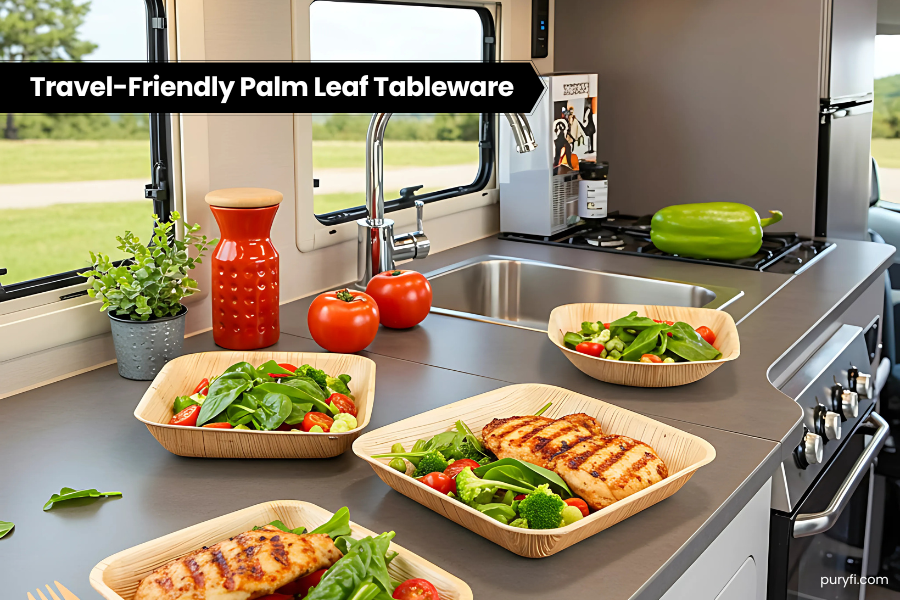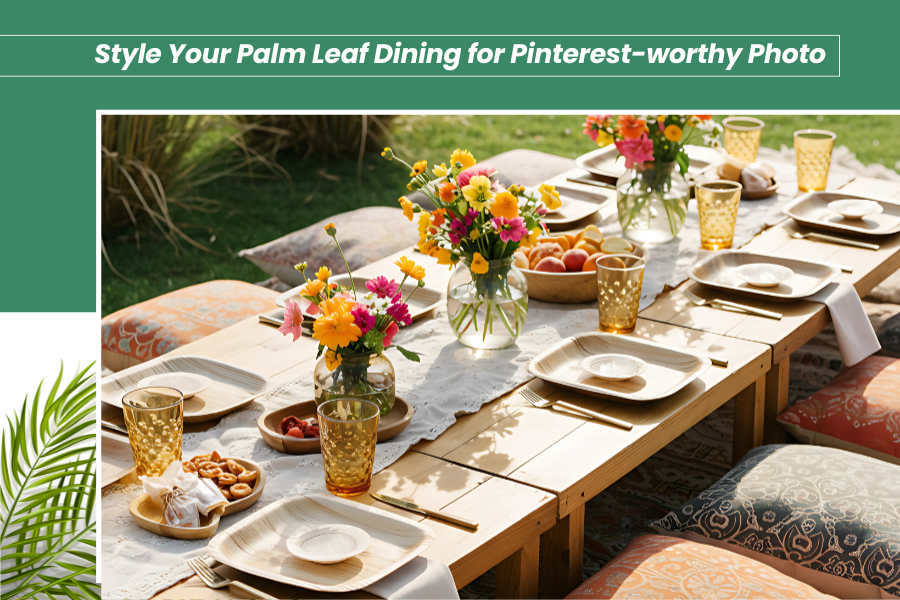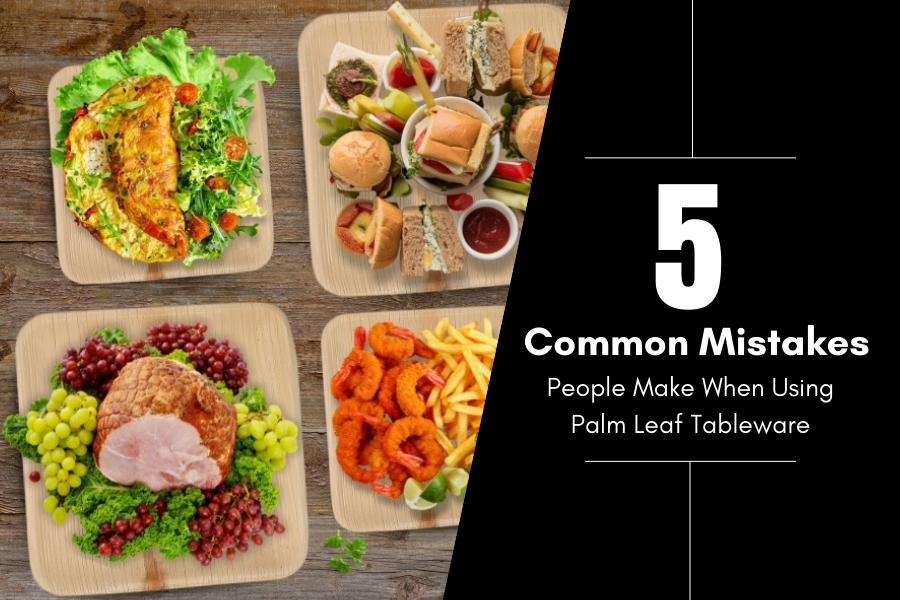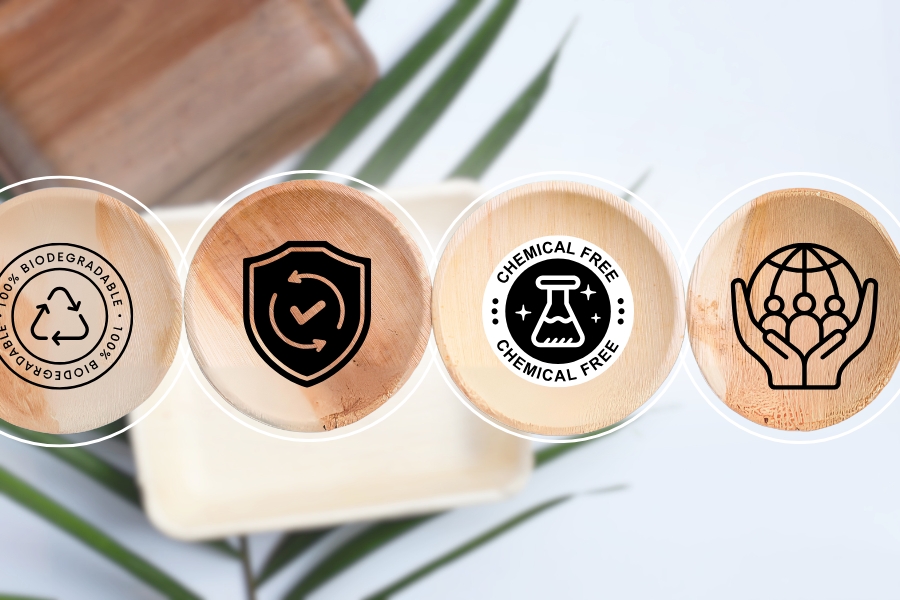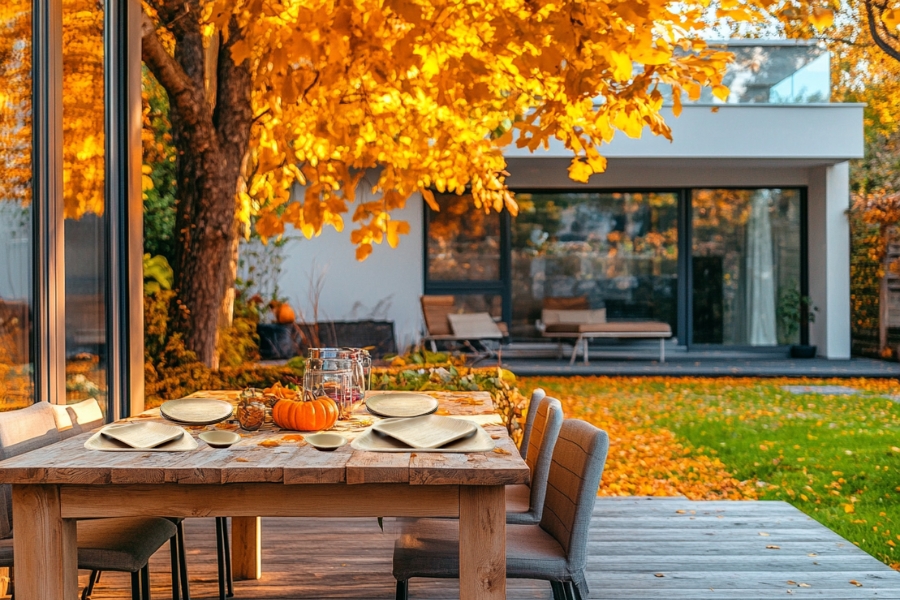Planning a kids’ party is as much fun as it is chaotic – uncontrolled waves of laughter, giggling, running, crazy games, but be ready for spilled drinks, broken plates, and the never-ending clean-up! The last thing you need is to worry about sharp shards or harmful chemicals. Plastic or paper disposable plates have always been the only resort despite their fragility and toxin leaching. However, eco-friendly disposable palm leaf plates and bowls are your true party partners now. It’s sturdy enough to handle enthusiastic little hands, hygienic, non-toxic, and fully compostable, perfect for everything from birthday parties to school picnics and backyard playdates. Say goodbye to mess and waste, and hello to stress-free, eco-friendly celebrations!
Eco-friendly Disposable Tableware for Your Road Trips
When planning your next outdoor adventure, whether it’s a weekend camping trip, a long RV journey, or a picnic by the beach, there’s one essential you might be overlooking: the tableware. Traditional plastic or foam plates can be flimsy, toxic, and harmful to the environment. That’s where biodegradable and disposable palm leaf tableware steps in as a game-changer.
Style Your Palm Leaf Dining for Pinterest-worthy Photo
In today’s world, where the hype and importance of social media are everywhere, the perfect photo can make all the difference, especially when promoting eco-conscious living and products like palm leaf tableware. This biodegradable tableware is not only compostable and non-toxic, but also incredibly photogenic, thanks to its organic texture and earthy tones. Whether you’re a brand, a food blogger/stylist, or someone who enjoys mindful dining, learning how to style palm leaf plates can boost your engagement across Instagram, Pinterest, or your blog. Here are some ideas for food plating photos for social media posts with eco-friendly palm leaf disposable plates.
Top 5 Reasons to Make the Switch to Plastic-Free Tableware
Let’s be real; most of us try to make better choices. Whether it is skipping the straw at a café, bringing reusable bags to the store, or shopping from brands that feel right, it all adds up. However, here’s the catch: buzzwords like “sustainable,” “biodegradable,” and “ethically sourced” get thrown around so much that they start to lose their meanings!
5 Mistakes People Make When Using Palm Leaf Tableware
Love eco-friendly tableware? Make sure you’re using it right! Palm Leaf Tableware is a fantastic alternative to plastic and paper plates. They’re eco-friendly, compostable, and stylish—perfect for parties, picnics, and even weddings. However, many people unknowingly make mistakes when using them, which can affect their experience. Are you guilty of any of these? Let’s find out!
Biodegradable Tableware: How Fast Do Palm Leaf Plates Decompose?
Going green isn’t just about big moves like solar panels and electric cars. Sometimes, it starts with something as simple as what’s on your dinner table. Biodegradable tableware is having a moment, and for good reason. It helps cut down waste and skips the plastic guilt.
10 Inspiring Stories of Communities Switching to Sustainable Tableware
In today’s fast-paced world, communities around the globe are taking remarkable steps to embrace sustainability. One of the most innovative and practical changes is the switch to sustainable tableware, particularly palm leaf products. These communities are not only reducing their environmental footprint but also inspiring others to follow suit. Here are ten inspiring stories showcasing their efforts: 1. A Beachside Town Bans Plastic at Festivals In a small coastal town in Kerala, India, local authorities introduced palm leaf tableware at their annual cultural festival. The move reduced plastic waste by 80%, and the leftover plates were composted into fertilizer for local farms. Visitors praised the eco-friendly initiative, leading to its adoption in neighboring towns. 2. School Lunch Programs in California Go Green A school district in California replaced plastic trays and utensils with palm leaf plates and wooden cutlery in its lunch program. This shift taught students about sustainability and significantly reduced the district’s waste output. The initiative also sparked student-led campaigns to further promote environmental consciousness. 3. A Zero-Waste Wedding Trend in Europe In the Netherlands, a group of eco-conscious couples began using palm leaf tableware for their weddings. The trend caught on, with wedding planners incorporating these biodegradable options into their services. Guests loved the rustic charm and sustainability of the tableware, making it a popular choice for events across the country. 4. Street Food Vendors in Southeast Asia Lead the Way In Bangkok, Thailand, street food vendors switched to palm leaf plates to address the growing problem of litter. Supported by local NGOs, this change not only helped vendors reduce costs but also made the streets cleaner. Tourists applauded the move, boosting the vendors’ popularity. 5. An Eco-Village’s Complete Transformation An eco-village in Costa Rica decided to eliminate single-use plastics entirely. Residents use palm leaf plates for community meals, celebrations, and daily dining. The village’s waste management system thrives on composting, and their success has attracted eco-tourists from around the world. 6. Corporate Offices Embrace Green Dining A tech company in Bangalore, India, replaced plastic cutlery and plates in its cafeteria with sustainable alternatives. Employees appreciated the initiative, and the company’s green dining policy became a benchmark for corporate sustainability practices. 7. Farmers’ Markets in New York Set an Example Farmers’ markets in upstate New York partnered with local suppliers of palm leaf tableware to offer eco-friendly packaging. This move drastically cut down on waste from food stalls and inspired customers to adopt similar practices at home. 8. Religious Gatherings Go Plastic-Free During a massive pilgrimage in South India, organizers distributed food on palm leaf plates to millions of devotees. This effort eliminated tons of plastic waste, showcasing the power of collective action in promoting sustainability at large-scale events. 9. Community Centers in Australia Advocate for Change In Melbourne, community centers replaced disposable tableware with palm leaf alternatives for workshops and gatherings. Local volunteers organized workshops on the benefits of sustainable living, encouraging attendees to incorporate these practices into their daily lives. 10. Eco-Friendly Cafés in Canada Inspire Customers A chain of eco-friendly cafés in Vancouver switched to palm leaf plates and compostable packaging. The move aligned with the city’s zero-waste goals and attracted a loyal customer base of environmentally conscious diners. The café’s story inspired other businesses in the area to adopt similar measures. Conclusion These ten remarkable stories illustrate the transformative power of communities embracing sustainable tableware. By making the switch, diverse groups—including schools, wedding organizers, corporate teams, and festival planners—demonstrate how simple yet thoughtful choices can lead to meaningful environmental improvements. Each initiative showcases unique challenges and creative solutions, proving that even small adjustments, like opting for compostable or reusable alternatives, can significantly reduce waste and lessen the environmental footprint. Beyond the immediate benefits, these examples highlight the ripple effect of such decisions, inspiring others to follow suit. Whether it’s students promoting eco-conscious practices, couples celebrating love with zero-waste weddings, companies reducing plastic at events, or festival-goers enjoying eco-friendly celebrations, the message is clear: collective action can drive substantial change. Together, these stories reaffirm the potential of shared efforts to create a greener, more sustainable future for generations to come.
Science Behind Palm Leaf Tableware Biodegradability
Palm leaf tableware is derived from the Areca palm tree, which sheds its leaves naturally. The shredded leaves undergo bare minimal processing, which includes cleaning, shaping through heat pressing, and drying. This process keeps the material’s structure largely intact, preserving its organic integrity. Palm leaf tableware is made from naturally shed palm leaves, there is a whole process encompassing, collecting the leaves, cleaning them, molding, buffing and then reaching you. Not only these are sturdy and stylish but are absolutely eco friendly and henceforth offers sustainable biodegradability. Now the question is how it takes place. There is a whole lot of nature involved in the biodegradable process. What makes palm leaf tableware biodegradable? The Breakdown Process Palm leaf tableware typically festers within 60 to 90 days in ideal composting conditions. The decomposition rate may vary depending on environmental factors like temperature, moisture, and exposure to air. Unlike plastic or Styrofoam, which can take hundreds of years to degrade, palm leaf tableware returns to the earth in just a few months, leaving no trace behind. In a home composting setup, where conditions are not as controlled as industrial composting facilities, the breakdown might take slightly longer. However, even in a natural environment like a backyard compost bin, palm leaf plates and bowls will still decompose much faster than plastic-based disposables. ENVIRONMENTAL BENEFITS OF SUSTAINABLE TABLEWARE The Sustainable Life Cycle of Palm Leaf Tableware The lifecycle of palm leaf tableware is a closed-loop system, from production to disposal.The raw material; the naturally shredded leaves, doesn’t involve cutting down trees or using harmful chemicals. As soon as the leaves fall down they are collected and are processed using heat and pressure to forge the amazing tableware. After use, the plates and bowls can be composted while breaking down and returning to the soil, completing the sustainable lifecycle and eventually lowering the environmental footprint. From the very start towards the end it proffers a green solution for minimizing waste and protecting our planet. Conclusion: Nature’s Perfect Solution You must have read “Say no to plastic” slogans everywhere, so what is making you wait, let’s take our little step towards creating an environment by using this amazing palm leaf tableware for our get togethers, parties and even day to day life. The biodegradability factor, strength, and total chemical-free composition make it a non-pariel eco-friendly alternative to plastic and other disposable options that harm the environment in one way or the other. By opting for palm leaf tableware, we’re not only making a sustainable choice for ourselves but also contributing to a healthier planet by minimizing waste and nurturing the soil through composting.and hence, the next time you’re planning an event or meal, consider making the switch to palm leaf tableware.
5 Doable Ways to Incorporate Sustainability
Sustainability isn’t just a buzzword; it’s about making smarter choices that are good for the planet and doable in everyday life. It’s not about being perfect, but about building habits that, over time, lead to real change.
Celebrate Sustainably: 5 Reasons Compostable Tableware is Perfect for Fall
As the cool, crisp air of fall fills our days and the trees burst into vibrant colors, it’s the perfect time to come together with friends and family for cozy gatherings. This season of warmth and connection is also a great opportunity to embrace more planet-friendly choices.



